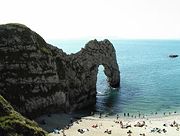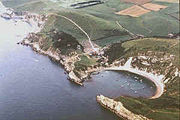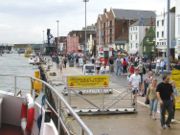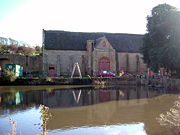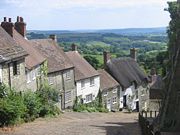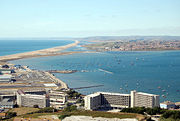Dorset
2008/9 Schools Wikipedia Selection. Related subjects: Geography of Great Britain
| Dorset | |
| Motto of County Council: Who's afear'd | |
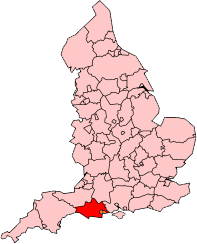 |
|
| Geography | |
| Status | Ceremonial & (smaller) Non-metropolitan county |
|---|---|
| Origin | Historic |
| Region | South West England |
| Area - Total - Admin. council - Admin. area |
Ranked 20th 2,653 km² (1,024 sq mi) Ranked 21st 2,542 km² (981 sq mi) |
| Admin HQ | Dorchester |
| ISO 3166-2 | GB-DOR |
| ONS code | 19 |
| NUTS 3 | UKK22 |
| Demography | |
| Population - Total (2005) - Density - Admin. council - Admin. pop. |
Ranked 32nd 701,100 265/km² (686/sq mi) Ranked 32nd 403,000 |
| Ethnicity | 98.1% White |
| Politics | |
 Dorset County Council http://www.dorsetforyou.com/ |
|
| Executive | Conservative |
| Members of Parliament | |
| Districts | |

Neighbouring counties are (A–D): Devon, Somerset, Wiltshire and Hampshire |
|
Dorset (pronounced /ˈdɔːsɪt/) (or archaically, Dorsetshire), is a county in South West England on the English Channel coast. The county town is Dorchester, situated in the south of the county at . Between its extreme points Dorset measures 80 kilometres (50 mi) from east to west and 64 km (40 mi) north to south, and has an area of 2,653 square kilometres (1,024 sq mi). Dorset borders Devon to the west, Somerset to the north-west, Wiltshire to the north-east, and Hampshire to the east. Around half of Dorset's population lives in the South East Dorset conurbation. The rest of the county is largely rural with a low population density. Dorset's motto is 'Who's Afear'd'.
Dorset is famous for the Jurassic Coast World Heritage Site, which features landforms such as Lulworth Cove, the Isle of Portland, Chesil Beach and Durdle Door, as well as the holiday resorts of Bournemouth, Poole, Weymouth, Swanage, and Lyme Regis. Dorset is the principal setting of the novels of Thomas Hardy, who was born near Dorchester. The county has a long history of human settlement and some notable archaeology, including the hill forts of Maiden Castle and Hod Hill.
History
The earliest recorded use of the name was in AD 940 as Dorseteschire, meaning the dwellers (saete) of 'Dornuuarana' (Dorchester)
The first known settlement of Dorset was by Mesolithic hunters, from around 8000 BC. Their populations were small and concentrated along the coast in the Isle of Purbeck, Weymouth and Chesil Beach and along the Stour valley. These populations used tools and fire to clear these areas of some of the native Oak forest. Dorset's high chalk hills have provided a location for defensive settlements for millennia, there are Neolithic and Bronze Age burial mounds on almost every chalk hill in the county, and a number of Iron Age hill forts, the most famous being Maiden Castle. The chalk downs would have been deforested in the Iron Age, making way for agriculture and animal husbandry.
Dorset has notable Roman artefacts, particularly around the Roman town Dorchester, where Maiden Castle was captured from the Celtic Durotriges by a Roman Legion in 43 AD under the command of Vespasian, early in the Roman occupation. Roman roads radiated from Dorchester, following the tops of the chalk ridges to the many small Roman villages around the county. In the Roman era, settlements moved from the hill tops to the valleys, and the hilltops had been abandoned by the fourth century. A large defensive ditch, Bokerley Dyke, delayed the Saxon conquest of Dorset from the north east for up to two hundred years. The Domesday Book documents many Saxon settlements corresponding to modern towns and villages, mostly in the valleys. There have been few changes to the parishes since the Domesday Book. Over the next few centuries the settlers established the pattern of farmland which prevailed into the nineteenth century. Many monasteries were also established, which were important landowners and centres of power.
In the 12th-century civil war, Dorset was fortified with the construction of the defensive castles at Corfe Castle, Powerstock, Wareham and Shaftesbury, and the strengthening of the monasteries such as at Abbotsbury. In the 17th-century English Civil War, Dorset had a number of royalist strongholds, such as Sherborne Castle and Corfe Castle, which were ruined by Parliamentarian forces in the war. In the intervening years, the county was used by the monarchy and nobility for hunting and the county still has a number of Deer Parks. Throughout the late Mediaeval times, the remaining hilltop settlements shrank further and disappeared. From the Tudor to Georgian periods, farms specialised and the monastic estates were broken up, leading to an increase in population and settlement size. During the Industrial Revolution, Dorset remained largely rural, and retains its agricultural economy today. The Tolpuddle Martyrs lived in Dorset, and the farming economy of Dorset was central in the formation of the trade union movement.
Physical geography
Most of Dorset's landscape falls into two categories, determined by the underlying geology. There are a number of large ridges of limestone downland, much of which have been cleared of the native forest and are mostly grassland and some arable agriculture. These limestone areas include a band of chalk which crosses the county from south-west to north-east incorporating Cranborne Chase, the Dorset Downs and Purbeck Hills. Between the areas of downland are large, wide clay vales (primarily Oxford Clay with some Weald Clay and London Clay) with wide flood plains. These vales are primarily used for dairy agriculture, dotted with small villages, farms and coppices. They include the Blackmore Vale ( Stour valley) and Frome valley.
South-east Dorset, around Poole and Bournemouth, lies on very non-resistant Eocene clays (mainly London Clay and Gault Clay), sands and gravels. These thin soils support a heathland habitat which supports all seven native British reptile species. The River Frome estuary runs through this weak rock, and its many tributaries have carved out a wide estuary. At the mouth of the estuary sand spits have been deposited turning the estuary into Poole Harbour, one of several worldwide which claim to be the second largest natural harbour in the world (after Sydney Harbour, though Sydney's claim is disputed). The harbour is very shallow in places and contains a number of islands, notably Brownsea Island, famous for its Red Squirrel sanctuary and as the birthplace of the Scouting movement. The harbour, and the chalk and limestone hills of the Purbecks to the south, lie atop Britain's largest onshore oil field. The field, operated by BP from Wytch Farm, produces a high-quality oil and boasts the world's oldest continuously pumping well ( Kimmeridge, since the early 1960s) and longest horizontal drill (8 km/5 mi, ending underneath Bournemouth pier). The pottery produced by Poole Pottery from the local clays is famous for its quality.
Most of Dorset's coastline was designated a World Heritage Site in 2001 because of its geological landforms. The coast documents the entire Mesozoic era from Triassic to Cretaceous, and has yielded many important fossils, including the first complete Ichthyosaur and fossilised Jurassic trees. The coast also features examples of most notable coastal landforms, including a textbook example of cove ( Lulworth Cove) and natural arch ( Durdle Door). Jutting out into the English Channel is a limestone island, the Isle of Portland, connected to the mainland by Chesil Beach, a tombolo.
In the west of the county the chalk and clay of south-east England begins to give way to the marl and granite of neighbouring Devon. Until recently Pilsdon Pen at 277 metres (909 ft), was thought to be the highest hill in Dorset, but recent surveys have shown nearby Lewesdon Hill to be higher, at 279 metres (915 ft). Lewesdon is also a Marilyn.
The county has the highest proportion of conservation areas in England— including an Area of Outstanding Natural Beauty (44% of the whole county), a World Heritage Site (114 km/71 mi), two Heritage Coasts (92 km/57 mi) and Sites of Special Scientific interest (199.45 km²/49,285 acres). The South West Coast Path, a National Trail, runs along the Dorset coast from the Devon boundary to South Haven Point near Poole.
The climate of Dorset has warm summers and mild winters, being the third most southern county in the UK, but not westerly enough to be afflicted by the Atlantic storms that Cornwall and Devon experience. Dorset shares the greater winter warmth of the south-west (average 4.5 to 8.7 °C or 40° to 48 °F), while still maintaining higher summer temperatures than that of Devon and Cornwall (average highs of 19.1 to 22.2 °C or 66° to 72 °F). The average annual temperature of the county is 9.8 to 12 °C (50°–54 °F), apart from the Dorset Downs. In coastal areas around Dorset it almost never snows.
The south coast counties of Dorset, Hampshire, West Sussex, East Sussex and Kent enjoy more sunshine than anywhere else in the United Kingdom, receiving 1541–1885 hours. Average annual rainfall varies across the county—southern and eastern coastal areas receive as little as 741 mm (29.2 in) per year, while the Dorset Downs receive between 1,061 and 1,290 mm (41.7–50.8 in) per year; less than Devon and Cornwall to the west but more than counties to the east.
Demographics
Dorset has a population of 407,217, plus 165,370 in Bournemouth and 137,562 in Poole (total 710,149—mid-year estimates for 2006). The following statistics exclude Poole and Bournemouth, which are no longer part of the administrative county. 98.7% of Dorset's population are of white ethnicity, an extreme example of the disproportionately small ethnic minority population in rural areas. 77.9% of the population are Christian and 13.7% are not religious. Dorset has the highest proportion of elderly people of any county in the United Kingdom: 27.4% of the population are over 65.
The county has one of the lowest birth rates of the 34 shire English counties, at 8.7 births per 1000, compared to the England and Wales average of 12.1/1000. It has the third highest mortality rate (12.0/1000), behind East Sussex and Devon. In 1996 deaths exceeded births by 1,056, giving a natural population decline of 2.7 per 1000, however, in 1997 there were 7,200 migrants moving to Dorset and the Poole-Bournemouth conurbation, giving Dorset the second highest net population growth, behind Cambridgeshire, at 17.3‰.
Politics
Dorset County Council is based at County Hall in Dorchester. Following the local council elections in May 2005, 24 Conservative, 16 Liberal Democrat, four Labour and one independent councillor sit on the county council. All Labour councillors were elected in the built up area of Weymouth and Portland; rural areas elected Conservatives and Liberal Democrat councillors.
This pattern is repeated at the national level. South Dorset is represented in Parliament by Labour MP Jim Knight, though this constituency was Labour's smallest majority and was one of the most fiercely contested seats in the General Election of 2005. In the event, the seat went against the national trend and Mr Knight's majority increased slightly on a swing from the Conservatives. In all other Dorset constituencies, the Conservatives and Liberal Democrats are the most successful parties: Mid-Dorset and North Poole is represented by the Liberal Democrats, and West Dorset, Christchurch and North Dorset by the Conservatives.
The built up area of Poole and Bournemouth is divided into three constituencies, Bournemouth East, Bournemouth West and Poole, all of which are represented by Conservative MPs. Dorset, the rest of the south west, and Gibraltar are in the South West England constituency of the European Parliament.
Economy and industry
In 2003 the gross value added (GVA) for the county was £4,673 million, with an additional £4,705 million for Poole and Bournemouth. 4% of GVA was produced by primary industry, 26% from secondary industry and 70% from tertiary industry. The average GVA for the 16 regions of South West England was £6,257 million. The GVA per person is £11,475 for Dorset, £15,532 for Poole and Bournemouth, £15,235 for the South West and £16,100 for the UK.
The principal industry in Dorset was once agriculture. It has not, however, been the largest employer for many decades as mechanisation has substantially reduced the number of workers required. Agriculture has become less profitable and the industry has declined further. Between 1995 and 2003 GVA for primary industry (largely agriculture with some fishing and quarrying) declined from £229 to 188 million—7.1% to 4.0% of the county's GVA. In 2002, 1,903 km² (735 sq mi) of the county was in agricultural use, down from 1,986 km² (767 sq mi) in 1989, although the figure has fluctuated somewhat. Cattle is the most common animal stock in the county, their numbers fell from 240,413 to 178,328 in the same period; the dairy herds fell from 102,589 to 73,476. Sheep and pig farming has declined similarly.
West Dorset General Hospitals NHS Trust employs around 2,500 multi-disciplinary staff; the majority at the 500-bed Dorset County Hospital which provides a turnover of £76 million. This new hospital was a larger replacement for Dorchester Hospital, which was built in 1840, and closed in 1998.
One of Dorset's famous products is the Dorset Knob, a hard biscuit. It can be used as an accompaniment to cheese, especially the local Dorset cheese, Blue Vinney.
Tourism has grown as an industry in Dorset since the early 19th century. 4.2 million British tourists and 260,000 foreign tourists visited the county in 2002, spending a combined total of £768 million. Foreign tourism declined in 1999 (310,000, down from 410,000 in 1998), and again in 2002 (down from 320,000 in 2001), the latter decline being blamed on the effects of the global economy and security.
Dorset has little manufacturing industry, at 14.6% of employment (compared to 18.8% for the UK), and is ranked 30th out the 34 non-metropolitan English counties. The gross domestic product for the county is 84% that of the national average.
Dorset will host an Olympic event at the 2012 Summer Olympics – sailing – at the Weymouth and Portland National Sailing Academy in Portland Harbour. Weymouth and Portland's waters have been credited by the Royal Yachting Association as the best in Northern Europe.
Culture
As a largely rural county, Dorset has fewer major cultural institutions than larger or more densely populated areas. Major venues for concerts and theatre include Poole Borough Council's Lighthouse arts centre, Bournemouth's BIC and Pavilion Theatre, Wimborne's Tivoli Theatre, and the Pavilion theatre in Weymouth. Dorset's most famous cultural institution is perhaps the Bournemouth Symphony Orchestra, founded in 1893 and now one of the country's most celebrated orchestras.
Dorset is not especially famous in sport, though Football League One A.F.C. Bournemouth, Conference National Weymouth F.C., and minor county cricket club Dorset CCC play in the county. The county is notable for its watersports, however, which take advantage of the sheltered waters of Weymouth and Poole bays, and Poole and Portland Harbours.
Dorset is famed in literature for being the native county of author and poet Thomas Hardy, and many of the places he describes in his novels in the fictional Wessex are in Dorset, which he renamed South Wessex. The National Trust owns Thomas Hardy's Cottage, in woodland east of Dorchester, and Max Gate, his former house in Dorchester. Several other writers have called Dorset home, including Douglas Adams (author of The Hitchhiker's Guide to the Galaxy), who lived in Stalbridge for a time; Ian Fleming (James Bond), who boarded at Durnford School, poet William Barnes; Theodore Francis Powys; John le Carré, author of espionage novels; Tom Sharpe of Wilt fame lives there as does P.D. James ( Children of Men); satirical novelist Thomas Love Peacock; John Fowles ( The French Lieutenant's Woman), lived in Lyme Regis before he died in late 2005; John Cowper Powys, who set a number of his most famous novels in Dorset and Somerset; and Robert Louis Stevenson wrote The Strange Case of Dr Jekyll and Mr Hyde while living in Bournemouth.
Dorset is also the birthplace of artist Sir James Thornhill, musicians John Eliot Gardiner, P.J. Harvey and Robert Fripp, photographer Jane Bown, palaeontologist Mary Anning and archbishops John Morton and William Wake. Explorer Sir Walter Raleigh lived in Dorset for some of his life, while scientist and philosopher Robert Boyle lived in Stalbridge Manor for a time; the naturalist Alfred Russell Wallace was also a resident, and is buried at Broadstone. Dorset is a popular home for celebrities. Those who have moved to or own second homes in Dorset include Madonna and Guy Ritchie, actor Martin Clunes, singer-songwriter Billy Bragg, Jonathan Ross, Oasis singer Noel Gallagher and footballer Jamie Redknapp. Many of Hugh Fearnley-Whittingstall's television programmes are filmed at his home, just outside of Bridport. Tim Berners-Lee, inventor of the World Wide Web lived in Colehill near Wimborne. Classical composer Muzio Clementi lived and worked near Blandford in Dorset.
Settlements and communications
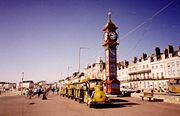
Dorset is largely rural with many small villages, few large towns, and no cities. The largest conurbation is the South East Dorset conurbation which consists of the seaside resort of Bournemouth, the historic port of Poole and the town of Christchurch plus many villages. Bournemouth was created in the Victorian era when sea bathing became popular. As an example of how affluent the area has become, Sandbanks in Poole was worthless land unwanted by farmers in the nineteenth century, but is said to be amongst the highest land values by area in the world. Bournemouth and Christchurch were added to the county from Hampshire in the county boundary changes of 1974.
The other two major settlements in the county are Dorchester, (the county town), and Weymouth, one of the first tourist towns, frequented by George III, and still very popular today. Blandford Forum, Sherborne, Gillingham, Shaftesbury and Sturminster Newton are historical market towns which serve the farms and villages of the Blackmore Vale (Hardy's Vale of the Little Dairies). Blandford is home to the Badger brewery of Hall and Woodhouse. Bridport, Lyme Regis, Wareham and Wimborne Minster are also market towns. Lyme Regis and Swanage are small coastal towns popular with tourists.
Still in construction on the western edge of Dorchester is the experimental new town of Poundbury, commissioned and co-designed by Prince Charles. The suburb is designed to integrate residential and retail buildings and counter the growth of dormitory towns and car-oriented development.
Dorset is connected to London by two main railway lines. The West of England Main Line runs through the north of the county at Gillingham and Sherborne. The South Western Main Line runs through the south at Bournemouth, Poole, Dorchester and the terminus at Weymouth. Additionally, the Heart of Wessex Line runs from Weymouth to Bristol. Dorset is one of only four non metropolitan counties in England not to have a single motorway. The A303, A31 and A35 trunk roads run through the county. The only passenger airport in the county is Bournemouth International Airport, and there are two passenger sea ports, at Poole and Weymouth, however the development of these towns both as ports and as industrial centres has over the years been severely constrained by under investment in infra-structure. There are no major trunk routes to the North and both towns remain cut off from the UK motorway network.
Education
Responsibility for education in Dorset is divided between three local authorities: Bournemouth and Poole unitary authorities and Dorset County Council, which covers the rest of the county.
The county of Dorset has a comprehensive education system, primarily based on First, Middle and Upper schools, with transfer between schools at age 9 and 13. This system has allowed the predominantly rural county to provide early years education close to home, and to minimise transport requirements for older students. As school populations have fallen in parts of the county, however, the authority has begun to reintroduce a primary/secondary system with transfer at age 11, particularly in the more urban areas such as in Blandford. There are 19 state and 8 independent upper or secondary schools in Dorset, with year sizes in the state schools of around 200.
Bournemouth has a selective system, with 10 state and 2 independent secondary schools, with transfer at age 11. Poole also has a selective system, with 8 state and 2 independent secondary schools, but primarily based on a Middle School system, transferring at age 8 and 12. Both councils have two single-sex selective grammar schools.
There are further education colleges in Bournemouth and Poole, and in Dorchester and Weymouth.
Bournemouth University is Dorset's only university-level institution.
